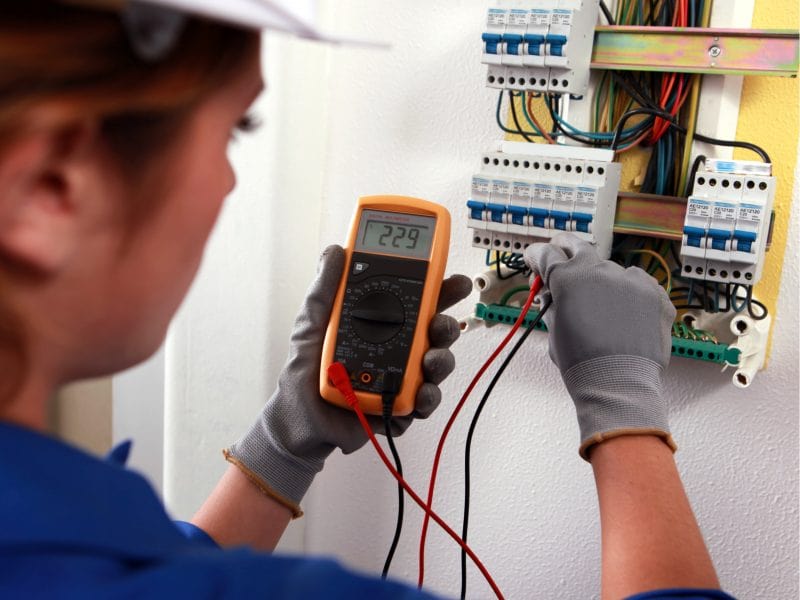This article deals with important methods of error analysis. Especially after serious accidents, an analysis of the causes is often necessary for legal reasons. But also small accidents, where fortunately not much happened, are important analysis material. The most important concept in this context is the so-called “root cause analysis”.
Tragic electrical accidents
Some electrical accidents are particularly tragic and serious. In a supermarket in Hamburg, the boy came into contact with a current-carrying railing in the checkout area. As a result of an electric current flowing through the body, the child suffered a heart attack, the consequences of which led to his death in hospital one day later.
At the beginning of last month, the trial of this disturbing event began. The accused are the operators of the supermarket, charged with negligent homicide. The defence, on the other hand, has announced that it intends to work towards an acquittal, as the operators are said to have been unaware of the inadequate safety standards of their electrical installations.
The question of guilt and human error
The discrepancy in opinions as to who is to blame for the tragic accident may seem almost cynical, especially in the present case. In fact, however, it can and should be seen as a symptom of an important problem that always exists in the background of such events. Every accident, including of course every electrical accident, is an event that arises from a complex web of causes.
Such causes can be, for example:
- Improper execution of electrical installations…
- Ignorance or lack of responsibility when it comes to checking the execution of such work or to instruct them to carry out such work prudently from the outset
- Lack of knowledge about first aid measures in case of electrical accidents
- Human error in general
- Lack of attention or insufficient sensitisation of persons not directly responsible, who nevertheless follow and influence events.
Instead of arguing about responsibilities solely in the aftermath of a serious accident, however important this may be, it would be far more constructive to consider who and what could have contributed to preventing the accident or accidents in general, from the outset.
Unfortunately, the omnipresence of electrical systems in our modern society is still matched by a generally insufficient level of risk awareness in dealing with them. It can hardly be explained otherwise that for decades the same causes of accidents have been leading the accident statistics.

Effective prevention
The complexity of the network of causes of serious accidents can be illustrated particularly well by the equally often neglected near-accidents. It is easy to see that a fault current in a railing or enclosure is not the sole cause of a serious accident if you consider how a serious accident could have been prevented under certain circumstances despite the presence of a fault current.
Attentive employees could have drawn attention to the amateurishly executed electrical installations, which, according to the public prosecutor’s office, are also recognisable to laypersons, and could have pressed for immediate repair, even out of their own safety interests. The operators could have eliminated such sources of error through regular checks. More caution in commissioning the electrician would have averted the danger from the outset.
Human failure always has its causes, which can be fought effectively by institutions. Of course, this requires a determined analysis of the exact structure of the failure at hand, both after serious accidents and especially after events in which “everything went well” and, of course, also preventively. Under no circumstances should one be satisfied with the fact that an actor in the accident was inattentive, but one must always ask oneself why the actor was inattentive.
Holistic accident analysis – root cause analysis
Often, as mentioned above, when analysing accidents, the main question is how exactly the accident happened, in order to find out who was ultimately responsible, in order to hold them accountable. The most important question Why the accident could have happened in this way and what (institutional) measures have to be taken to ensure that the next person responsible does not reproduce an identical or similar case is often not given sufficient attention.
In the long run, it is much more important to precisely determine the cause of the accident and to exclude it for the future than to determine the culprit and hold him responsible. Learning from mistakes is more important than punishing mistakes!
For exactly these questions and their systematic and successful answers, there is the instrument of root cause analysis. Such an analysis follows the following five principles:
The subject here is not exclusively accidents, i.e. events in which a person was actually physically injured. An analysis should also be carried out for all near-accidents, safety-relevant disturbances, incidents of damage and those cases in which only chance or lucky circumstances prevented the worst from happening.
In the search for the causes, all factors involved, such as technology, work equipment, work organisation and human behaviour must always be analysed. Hazards often only arise or are aggravated by the interaction of several factors.
It is not only about the obvious causes of an accident. They can lie in a disregard of safety regulations or in the failure of a component. But that is only half the truth. Because the actual cause of an accident is often deeper and may provoke further accidents.
The point is not to accept accidents as fateful and to file them away once a superficial causality has been established, but to systematically analyse them in order to find weak points in the safety efforts of the company.
The aim is always to learn from an accident in order to avoid repetition. This can mean reviewing and improving existing technical protection measures. It can also mean optimising and developing training, instructions, working methods or operational procedures etc.





